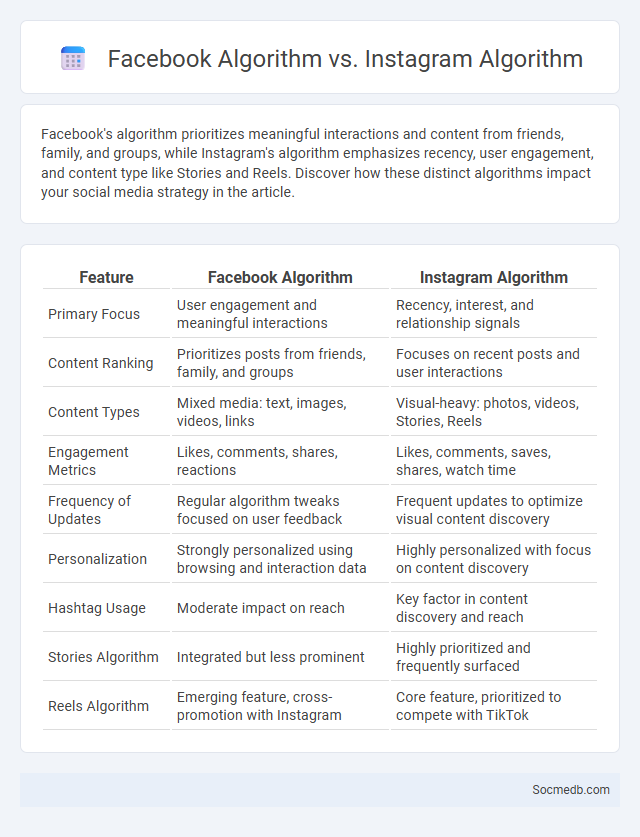
Photo illustration: Facebook Algorithm vs Instagram Algorithm
Facebook's algorithm prioritizes meaningful interactions and content from friends, family, and groups, while Instagram's algorithm emphasizes recency, user engagement, and content type like Stories and Reels. Discover how these distinct algorithms impact your social media strategy in the article.
Table of Comparison
| Feature | Facebook Algorithm | Instagram Algorithm |
|---|---|---|
| Primary Focus | User engagement and meaningful interactions | Recency, interest, and relationship signals |
| Content Ranking | Prioritizes posts from friends, family, and groups | Focuses on recent posts and user interactions |
| Content Types | Mixed media: text, images, videos, links | Visual-heavy: photos, videos, Stories, Reels |
| Engagement Metrics | Likes, comments, shares, reactions | Likes, comments, saves, shares, watch time |
| Frequency of Updates | Regular algorithm tweaks focused on user feedback | Frequent updates to optimize visual content discovery |
| Personalization | Strongly personalized using browsing and interaction data | Highly personalized with focus on content discovery |
| Hashtag Usage | Moderate impact on reach | Key factor in content discovery and reach |
| Stories Algorithm | Integrated but less prominent | Highly prioritized and frequently surfaced |
| Reels Algorithm | Emerging feature, cross-promotion with Instagram | Core feature, prioritized to compete with TikTok |
Introduction to Social Media Algorithms
Social media algorithms analyze your interactions, preferences, and behaviors to personalize the content displayed in your feed. These complex systems prioritize posts, advertisements, and recommendations that align with your interests, increasing engagement and time spent on the platform. Understanding how these algorithms work allows you to optimize your content reach and engagement effectively.
Overview of Facebook Algorithm
Facebook's algorithm prioritizes content that encourages meaningful interactions, emphasizing posts from friends, family, and groups over public content. It analyzes user behavior such as likes, comments, shares, and time spent on posts to rank the relevance of each piece of content in your News Feed. Your engagement patterns directly influence which posts appear, aiming to enhance your overall experience by delivering personalized and engaging content.
Overview of Instagram Algorithm
Instagram's algorithm prioritizes content based on user engagement, relevance, and timeliness, analyzing likes, comments, shares, and viewing time to tailor the feed. It incorporates machine learning to predict user preferences, emphasizing recent posts and interactions with close connections. Hashtags, content type, and user behavior also influence visibility, optimizing personalized content delivery for each profile.
Core Differences Between Facebook and Instagram Algorithms
Facebook's algorithm prioritizes content based on user engagement, such as comments and shares, aiming to foster meaningful social interactions within diverse interest groups. Instagram's algorithm emphasizes visual content relevance, using factors like timeliness, user activity, and relationship history to tailor your feed with posts, stories, and reels from close connections or popular creators. Understanding these core differences allows you to optimize content strategy effectively across both platforms for maximum reach and engagement.
Key Similarities in Algorithm Functionality
Social media algorithms primarily focus on user engagement metrics such as likes, comments, shares, and watch time to personalize content feeds. Machine learning models analyze user behavior patterns, including browsing history and interaction frequency, to predict and prioritize relevant posts. These algorithms continuously update their recommendations by processing vast amounts of real-time data to enhance user retention and content relevance.
How the Facebook Algorithm Prioritizes Content
The Facebook algorithm prioritizes content based on user engagement signals such as likes, comments, shares, and viewing duration, which indicate relevance and interest. It uses machine learning to analyze user behavior, personalizing the News Feed by showing posts from friends, groups, and pages with the highest predicted value. Content that generates meaningful interactions or aligns with the user's past preferences is algorithmically boosted to increase visibility and reach.
How the Instagram Algorithm Ranks Posts
The Instagram algorithm ranks posts by evaluating user engagement signals such as likes, comments, shares, and time spent on content to prioritize relevancy and interest for each individual. Your interactions with specific accounts, including direct messages and story views, heavily influence the visibility of their posts in your feed. By consistently engaging with content you find appealing, the algorithm identifies patterns and elevates similar posts to enhance your personalized experience.
User Engagement: Facebook vs Instagram
User engagement on social media platforms like Facebook and Instagram varies significantly due to differing content formats and audience behavior. Facebook's diverse features, including groups, events, and longer text posts, foster deeper discussions and community interaction, while Instagram's emphasis on visual content such as photos, stories, and reels drives higher immediate engagement through likes, comments, and shares. To maximize your online presence, understanding these nuances helps tailor your content strategy for more meaningful user interaction on each platform.
Impact on Brands and Content Creators
Social media dramatically shapes brand visibility and consumer engagement by enabling real-time interaction and personalized marketing strategies. Your brand can leverage data analytics from platforms like Instagram and TikTok to tailor content that resonates with target audiences, boosting loyalty and conversions. Content creators benefit from algorithm-driven exposure, monetization opportunities, and direct communication with followers, fostering authentic relationships and sustainable growth.
Future Trends in Social Media Algorithms
Future trends in social media algorithms will increasingly prioritize personalized content delivery through advanced AI and machine learning techniques, enhancing user engagement. Your interactions and preferences will shape the visibility of posts, prioritizing relevance and authenticity over generic popularity metrics. Expect more transparent algorithm updates aimed at reducing misinformation and promoting meaningful connections across platforms.
 socmedb.com
socmedb.com